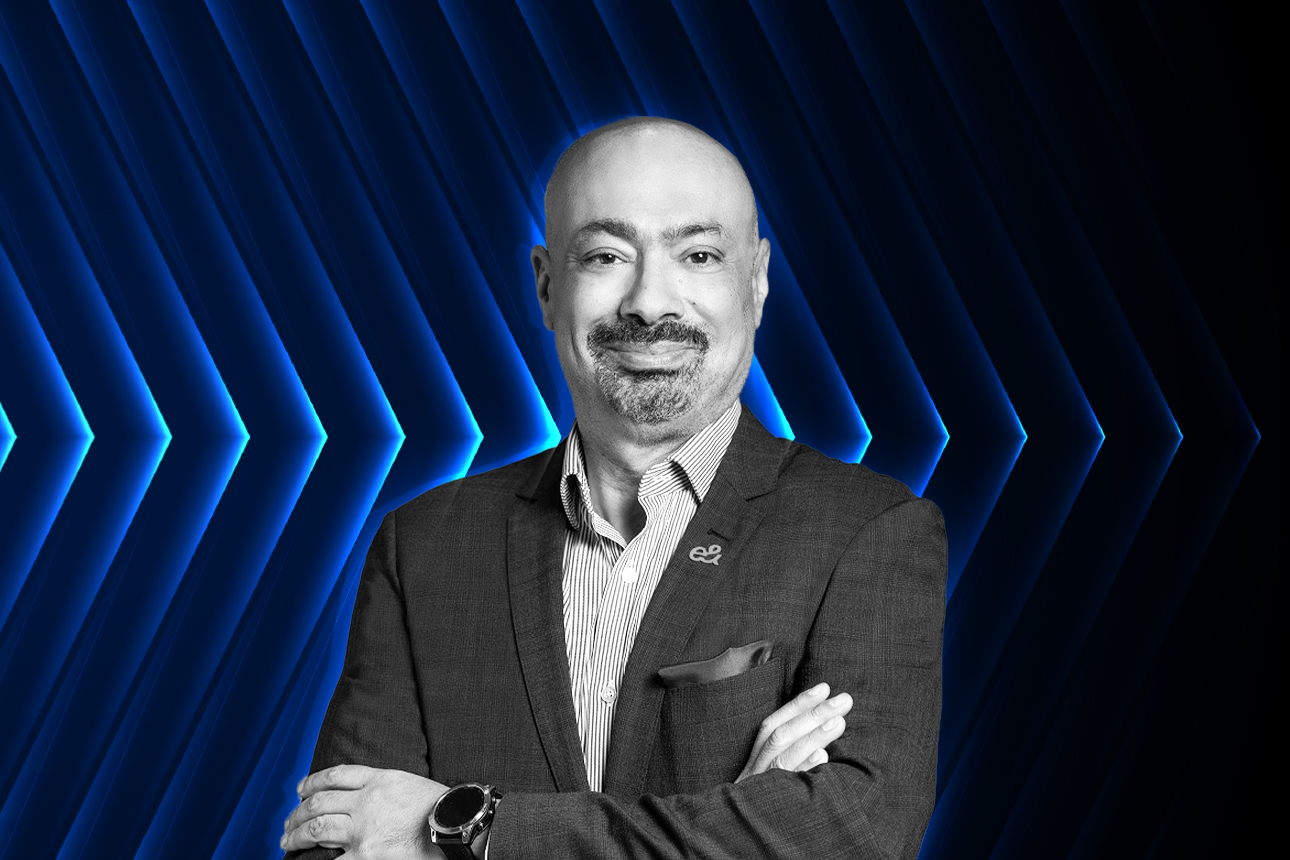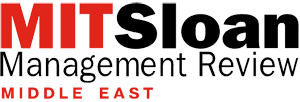Rewriting the Core: How e& Engineered Disruption from Within
e&'s transformation reveals key lessons in strategic reinvention, brand disruption, and proactive leadership, offering valuable insights for legacy organizations navigating change.
Topics
News
- Uber and WeRide Launch First Driverless Robotaxi Service Outside the U.S. and China
- UAE Unveils Its First Marketplace for Buying and Trading Trademarks
- ACI Flags Sharp Rise in ‘Friendly Fraud’ as Thanksgiving–Cyber Monday Spike Looms
- WhatsApp’s AI Clampdown to Send Microsoft Copilot Packing by Jan 2026
- Salesforce Adds Arabic to Agentforce to Meet the Demand for AI Systems
- Saudi Arabia’s CEOs Top the Charts on Confidence and AI Readiness, KPMG Reports

[Image source: e&/Krishna Prasad/MITSMR Middle East]
In early 2020, as the world ground to a halt and uncertainty gripped global markets, Hatem Dowidar stepped into his role as Group CEO of e&. For most executives, surviving disruption would have been enough. But Dowidar wasn’t interested in survival—he wanted to challenge the very identity of the company, known at the time as Etisalat.
The company was already a telecom giant: respected, profitable, and deeply embedded in the region’s infrastructure. But for Dowidar, who had been with the telecom leader for nearly half a decade, that legacy raised a deeper, fundamental question: “Why should we be satisfied with just being a telecom operator?” This question sparked a series of decisions that would ultimately reposition the company—from a legacy utility provider to a global technology and investment group.
Today, e& is the fastest-growing brand globally, with a portfolio spanning AI, fintech, cloud computing, digital services, and telecommunications. Its operating presence reaches 38 markets, nearly a quarter of its revenue comes from non-telecom businesses, and its brand portfolio and investment value has surpassed US$20 billion. The transformation wasn’t driven by crisis or competitive threats. It was a proactive, strategic bet on a new kind of relevance.
This article, based on a wide-ranging conversation between MIT SMR Middle East editor Liji Varghese and e& Group CEO Hatem Dowidar, explores how he approached reinvention—not as a reaction to disruption, but as a deliberate act of leadership. At its core is the understanding that brand transformation begins with organizational redefinition. The lessons from this journey provide valuable insights for other legacy companies facing similar challenges: How can you stay relevant without abandoning your foundation? What does it take to build a future-facing organization while maintaining the trust earned over decades? And how can leaders ensure that transformation goes beyond just a rebrand?
Reframing the Role of a Legacy Business
The most significant move e& made was as strategic as it was technological. Dowidar and his leadership team reframed what the company was fundamentally about. Connectivity, they believed, was no longer the final product; it was the starting point for broader value creation. This reframing led to the development of a new operating structure, built around five key business pillars:
- e& UAE: The company’s telecom foundation, focused on connectivity in its home market
- e& life: Consumer-facing digital services across entertainment, retail, and fintech
- e& enterprise: Digital transformation, AI, cloud, and cybersecurity for governments and businesses
- e& international: A portfolio of telecom and digital assets operating in 19 countries outside the UAE.
- e& capital: The company’s venture and investment arm
The new structure gave the company flexibility to pursue adjacent opportunities while preserving the strength of its telecom operations. It also created clear paths for growth in areas like AI, digital payments, and enterprise cloud services—sectors far removed from traditional telecom billing models.
“Our transformation was about embracing bold thinking, moving beyond boundaries, and ensuring that we were not just responding to change but leading it. Rather than waiting to be disrupted, we made a conscious decision to disrupt ourselves first.”
That required not only new investments but a willingness to rethink the company’s identity from the inside out.
Making Brand a Catalyst for Change
One of the major outcomes of this transformation was the company’s rebranding from Etisalat to e&. For a company with decades of brand equity in the UAE and across the region, this was a significant risk. But it was also a signal—internally and externally—that the company’s ambitions had evolved.
The rebrand wasn’t just about name or design. It reflected a shift in narrative. Under the e& umbrella, the company could speak with a single voice across all its lines of business, from fintech to cloud computing to entertainment. It also helped unify its acquisition strategy and created consistency across global markets.
For stakeholders, the new identity simplified the complexity of the group’s evolving structure. Internally, it served as a tool for alignment—offering employees a clearer understanding of where the company was going and how their roles were evolving. Externally, it repositioned the company as a tech-forward brand capable of competing in new sectors.
“One of the biggest challenges was repositioning a legacy brand that had long been synonymous with telecom excellence and trust. Expanding that perception to encompass a broader technology and investment vision required more than just a name change. It demanded strategic repositioning, a compelling narrative, and a unified brand identity that resonated with customers, investors, and partners alike.”
Brand, in this case, was used not as a wrapper for change, but as part of the engine driving it. In late 2024, the rebrand also served as a launchpad for a global brand positioning—Go for More. Featuring a powerhouse lineup of global icons—Jason Statham, Shah Rukh Khan, Lewis Hamilton, Megan Fox, Amina Khalil, and Ismail Mattar—the accompanying campaign showcased the universality of e&’s message: to inspire ambition and enable people everywhere to push boundaries. It highlighted the Group’s commitment to deliver richer digital experiences and connect with global audiences across cultures and interests.
The results followed. By 2025, e& had been named the World’s Fastest Growing Brand by Brand Finance with a brand value of USD 15.3 billion, achieved a AAA brand strength rating and joined the ranks of the world’s top 10 most valuable telecom brands.
The success is also a reminder that reinvention doesn’t require abandoning your roots. In fact, the strength of the legacy brand made the transformation possible.
Balancing Legacy and Innovation
For many legacy businesses, reinvention often involves distancing from the past. But transformation doesn’t have to come at the cost of foundational strengths. Instead, the group views its telecom foundation as a competitive advantage in building the future.
With over 194.8 million global customers across 38 markets, e& continues to invest in its connectivity backbone, particularly 5G. But it does so while simultaneously scaling AI-driven services, digital platforms, and enterprise solutions that meet the needs of individuals, businesses, and governments. Why? Because, its connectivity backbone is incidentally the backbone of any technological advancement.
“Rather than viewing legacy and innovation as separate paths, we see them as complementary forces. Our connectivity operations continue to thrive, powered by AI-driven network intelligence and seamless customer experiences, while our technology ventures create new opportunities for growth.”
The ability to evolve from a position of strength rather than necessity has become a cornerstone of the group’s strategy.
Leading Transformation Through Values and Discipline
At the core of the telco to techco transformation is a leadership model rooted in alignment—between personal values and corporate ambition, bold vision, and operational discipline. This alignment created clarity during complex shifts, allowing the company to move confidently into new industries without losing its identity.
“I believe true leadership begins when your personal values resonate with the company’s core principles. For me, this alignment has been the bedrock of authenticity and purpose in every decision.”
The leadership set the tone by embracing a “think big, act boldly, execute precisely” mindset. Ambition was paired with methodical follow-through and a deep focus on delivering value to customers. As the group expanded into technology and investment verticals, leadership ensured that every move was connected to impact—especially in customer experience, where innovation was used to anticipate needs, not just respond to them.
Strategic partnerships and internal cohesion were equally important. By aligning teams across business units and regions, e& was able to scale transformation initiatives at speed. Integrity and transparency anchored this momentum, reinforcing trust during moments of uncertainty. Agility—both operational and strategic—proved equally critical. In an era of accelerated disruption, the ability to adapt quickly while staying focused on long-term goals became a competitive advantage.
By 2025, this values-led, high-discipline approach had become a blueprint for transformation. These efforts were reflected in industry recognition, with the Group CEO named Telecom Guardian of the Year for the third consecutive year and featured across multiple regional leadership rankings.
Embedding Innovation as a Way of Working
When the pace of change demands more than traditional telecom agility, innovation can’t be treated as a standalone function. It has to be embedded into how the organization operates.
Rather than rely on top-down directives, e& created space for teams to challenge the status quo and act independently. Decision-making was pushed closer to the front lines, where employees had the context and confidence to move quickly. Removing silos and encouraging cross-functional collaboration became key levers for creativity. With diverse teams solving complex problems together, the quality and speed of innovation improved.
The cultural rewiring extended to how new ideas were tested. The leadership adopted a “fail fast, learn fast” mindset—ensuring that experimentation wasn’t punished but refined. Teams have the freedom to explore emerging technologies outside the constraints of daily operations. Internally, proprietary tech and enterprise platforms were developed to drive efficiencies at scale.
But the most meaningful investments were in people. Programs like the AI Graduate Programme, Excelerate& (with Ericsson), and the soon-to-launch AI Academy equip employees and Emirati youth with future-focused skills in AI, 5G, data science, and cloud computing. Initiatives like Bidayati emphasize both technical expertise and leadership readiness. These initiatives combined hands-on learning with strategic vision preparing employees to lead in an environment defined by constant change.
Collaboration and talent development remain a consistent thread throughout the group’s broader transformation journey, explored in more depth later in this article.
By 2025, its culture of innovation had become a defining characteristic. It was not limited to product development or R&D. It extended into how the company approached talent, partnerships, and long-term value creation anchored by a clear purpose to digitally empower societies at scale.
“Our vision to digitally empower societies gives meaning to our work and inspires our teams to think beyond short-term goals.”
Guiding Talent Through Technological Disruption
Leadership is not only about envisioning the future or building the next wave of innovation. It’s equally about leading the people who make that future possible. In times of disruption, this becomes even more critical.
History shows that every wave of technological advancement—whether the steam engine, electricity, or the internet—initially sparked anxiety over job displacement. AI is no exception. But the long-term impact of such innovations often lies in the opportunities they unlock. The role of leadership, then, is to help people see—and seize—those opportunities.
“Change can be unsettling, especially when it challenges long-established ways of working. Strong leadership provides the clarity, confidence, and direction needed to turn disruption into opportunity.”
The leadership decided to approach this challenge with transparency. Rather than positioning AI as a replacement for human talent, e& saw it as an amplifier—an enabler of greater efficiency, creativity, and impact. Open conversations are key. So is a clear roadmap that shows employees how their roles are evolving and how they can grow with them.
The shift is backed by strategic investment. From foundational programs like License to Lead and the Group Organisational Leadership Development (GOLD) initiative to advanced tracks like Citizen X and the Women Leadership Programme, the techco ensures its people are equipped with the technical fluency and leadership mindset to thrive in an AI-driven world. Its AI competency hub further accelerated this effort, integrating global expertise with internal talent to build cutting-edge capabilities from within.
The pandemic was a stress test—and a proof point. It showed how quickly employees could adapt when given the right tools, support, and clarity of direction. That same mindset now drives how e& leads through ongoing technological shifts: with agility, but anchored in human development.
Ultimately, innovation means little without people who are ready to deliver it. Leadership through disruption is measured not just by how well the company adapts—but by how well its people do.
“Technology will continue to evolve, but leadership is what determines whether an organization merely reacts to change or actively shapes the future.”
Building Around Artificial Intelligence
As the group redefined its identity, technology—and particularly artificial intelligence (AI)—emerged as the cornerstone of its operational model.
The integration of AI shows where the real transformation was happening. It was not an experimental initiative or a peripheral product feature, but is embedded across the organization. It has become central to how e& designs services, manages infrastructure, and scales operations. AI-powered autonomous stores, virtual assistants and voice-authentication tools improved customer support. Predictive analytics are used for network maintenance. For e& money, AI now enables real-time fraud detection, instant credit scoring, and two-minute onboarding.
“We are using AI to personalize customer experiences, automate networks, improve security, and make operations smarter and more efficient. But AI is not just about optimization for us—it is about building entirely new services and business models.”
It is also pioneering AI-driven infrastructure, including self-optimizing networks (SON) and AI-powered data centers, which predict failures, optimize energy use, and dynamically allocate resources to ensure seamless performance while cutting costs and minimizing environmental impact.
The scope of implementation is broad. Over 200 AI use cases are set to be delivered between 2025 and 2026. Of this 112 use cases are being rolled out this year alone. Even internal productivity is being rethought: embedding AI into workflows has increased employee output by 20%.
e& approached AI with structure and responsibility. It partnered with IBM to develop an end-to-end AI governance framework, is a contributor and an early adopter of the GSMA Responsible AI Maturity Roadmap and participates in global AI ethics forums, including the World Economic Forum and the United Nations Development Programme.
“Transformation goes hand-in-hand with our dedication to ethical and sustainable practices.”
Scaling Through Investment, Partnerships and Strategic Acquisitions
The transformation journey has been accelerated through carefully chosen investments, acquisitions and partnerships. The approach has been disciplined and strategic. It cultivated a pipeline of high-value opportunities, all aligned with its overarching strategy to drive long-term growth across multiple dimensions. The key focus is on doubling down on its telco core, diversifying its portfolio (expanding geographic footprint and venturing into digital adjacencies), digitize and transform it operations and pushing for sustainability in all aspects of its operations.
“Our approach to partnerships and acquisitions is disciplined and strategic, focused on capitalizing on high-value opportunities within a carefully cultivated pipeline of promising deals. Our investment decisions are always aligned with our strategic pillars and overarching group strategy, which is designed to drive long-term growth across multiple dimensions.”
Innovation doesn’t happen in silos. And not everything can be built from the ground up. The leadership understood this. The group fosters relationships with a wide range of players, including startups, tech providers, research institutions, and even competitors. This culture of shared innovation is central to e&’s ability to scale and stay ahead in a competitive market.
Recent Strategic Acquisitions and Partnerships
Key partnerships such as those with Huawei, Ericsson, Nokia, and Intel are pivotal in e& international’s journey to achieving Level 4 network autonomy by 2030. These collaborations allow e& to transform its mobile network infrastructure, integrating AI to create adaptive, intelligent networks capable of evolving in real-time. The impact of this transformation is already evident in e& UAE, where AI has significantly improved connectivity, making it faster, more reliable, and adaptive.
In research and development, e& collaborates with Nokia Bell Labs to co-develop AI-driven solutions for enterprise and industrial automation. These partnerships have gone beyond transactional agreements, evolving into multi-faceted relationships where the company co-develops intellectual property, shares resources, and sets industry standards. The concept of “co-opetition”—competing in some areas while collaborating in others—has proven to be a key driver of innovation.
e& capital, the company’s corporate venture capital arm, looks beyond the horizon, investing in promising startups that complement e&’s core business areas. Through these strategic investments, e& aims to build a future-ready digital ecosystem that supports business scaling, government innovation, and the development of vibrant communities.
e&’s international expansion came with the acquisition of PPF Telecom’s assets in Bulgaria, Hungary, Serbia, and Slovakia. This acquisition bolstered e&’s presence in Central and Eastern Europe, extending its telecom footprint to 19 countries and its operational reach to 38 markets across the Middle East, Asia, Africa, and now Europe. By building on PPF Telecom’s strong market foundation, e& introduced its cutting-edge digital products and services to new markets, enhancing both B2B and B2C offerings.
The acquisition of SBB Serbia Broadband is another significant step in strengthening e&’s footprint in Eastern Europe. With this €825 million deal, e& integrates one of Serbia’s largest high-speed internet and cable TV providers with Yettel Serbia. This move significantly enhances the company’s ability to offer seamless services to over 700,000 customers in the region. With a strong focus on becoming a fully converged operator, e& continues to expand its ability to serve diverse markets.
The partnership with Amazon Web Services (AWS) marks a major leap in its cloud capabilities. Over the next six years, the collaboration, valued at over $1 billion, combines AWS’s cloud infrastructure with e&’s network expertise. This partnership will drive innovation across key sectors such as healthcare, finance, and oil and gas, helping e& provide essential cloud services while enhancing customer experiences and operational efficiency.
The acquisition of GlassHouse strengthens its ability to offer multi-cloud and managed services to businesses, providing scalable, secure solutions.
This combination of scale, partnership, and investment has allowed e& to grow fast without stretching thin—each acquisition and deal tied directly to the group’s strategic pillars.
Navigating Risk in a Volatile Global Landscape
Operating across multiple markets comes with inevitable complexity—from regulatory shifts and political instability to currency risk. The leadership has addressed this challenge through a strategy of portfolio balancing. High-growth but volatile markets like Pakistan and Egypt are balanced by acquisitions in more stable economies like Serbia and Hungary.
The group also looks for opportunities to build scale through local partnerships, such as e& international’s Partner Markets Programme, which allows it to grow in places like Tunisia and Uzbekistan without taking on the full burden of operational control. Meanwhile, its 15.01% stake in Vodafone Group opens channels for collaboration across Africa, Europe, and the Middle East.
This risk management strategy—combining geographic diversification with strong local alliances—has allowed e& to navigate inflation, energy shocks, and FX fluctuations without derailing growth plans.
“An important aspect of our strategy is diversifying our portfolio to include more stable currencies, which helps mitigate the impact of currency fluctuations in the markets where we operate.”
It also reflects a broader understanding that transformation is not just about products and services it’s about building resilience at the organizational level.
Transformation Playbook For Legacy Organizations
- Leverage your history as a springboard into new, future-facing opportunities. Don’t be confined by your past.
- Disrupt yourself before someone else does. Set a clear vision and make bold moves.
- Rebranding should signal real change. Align internal teams and external audiences with a new purpose.
- Modernize by building on your core strengths. Innovate without abandoning what made you strong.
- Embed innovation into your culture and operations. Break silos and empower cross-functional creativity.
- Anchor transformation in authentic leadership and a clear, shared purpose.
- Be upfront about the impact of new technologies. Equip people to adapt and thrive.
- Upskill, empower, and trust your teams to drive transformation from within.
- Accelerate growth through partnerships and acquisitions that bring fresh capabilities and markets.
- Align transformation with sustainability and societal goals—not just short-term profits.
- Diversify into new markets and forge local partnerships to scale and manage volatility.
- Connect your transformation to national or global priorities to stay relevant and amplify impact.
The Road to Future
At the core of e&’s strategy is a strong commitment to sustainability. The Group is working toward achieving carbon neutrality (Scope 1 and 2) in the UAE by 2030 and across all markets by 2040, focusing on reducing carbon emissions and improving energy efficiency across its operations. The implementation of renewable energy solutions, combined with AI-driven infrastructure optimization, will support this goal. Through these initiatives, e& seeks to contribute meaningfully to global sustainability efforts while aligning with the UAE’s Net Zero 2050 Strategy.
Equally important to e&’s future is collaboration. Strategic partnerships with technology leaders, research institutions, and competitors alike will be key to co-creating innovative solutions, sharing resources, and expanding its digital ecosystem across geographies. This collaborative approach ensures that e& remains agile, innovative, and globally connected.
“As we build a future-ready digital ecosystem, we will also drive sustainable practices, ensuring that our operations contribute positively to the nation’s and the world’s long-term environmental goals.”
e&’s transformation was driven by a leadership decision to challenge assumptions, reframe value creation, and rewire the organization from within. It was not the scale of investment or the pace of execution, but the clarity of the questions being asked at each step: What business are we really in? What problems are we solving now? How do we need to operate to stay credible in a rapidly changing world?
For legacy organizations, the future doesn’t belong to those who just adapt—it belongs to those bold enough to reinvent.





